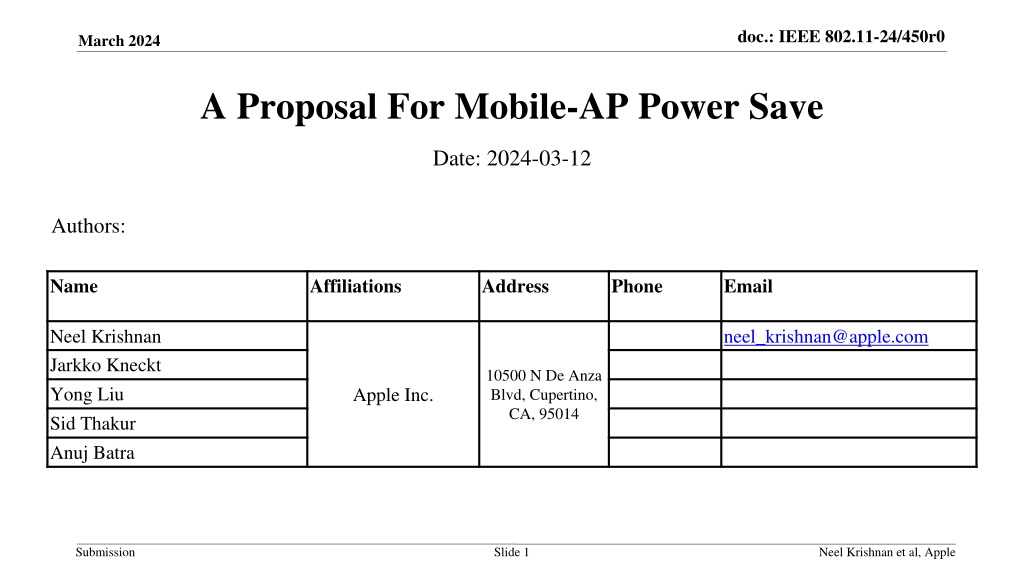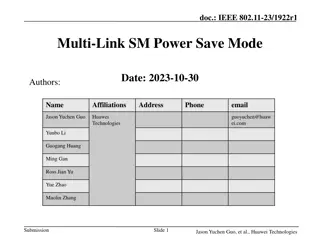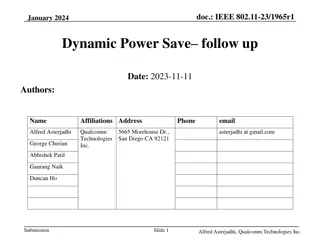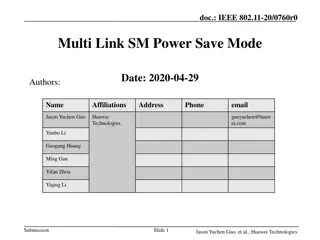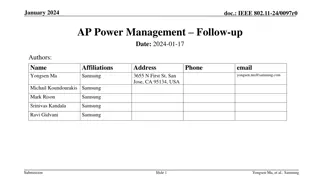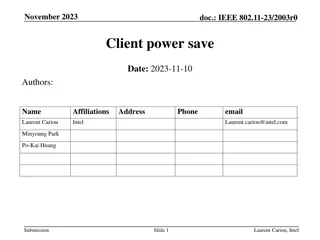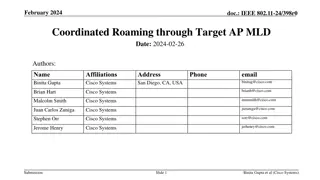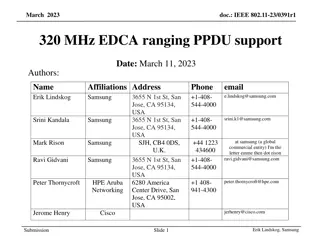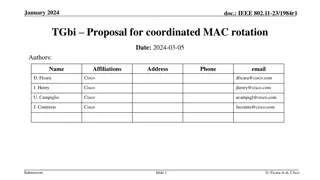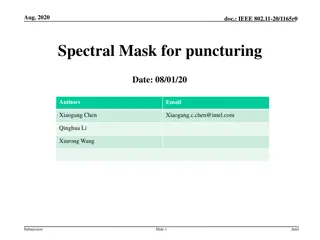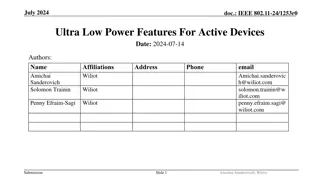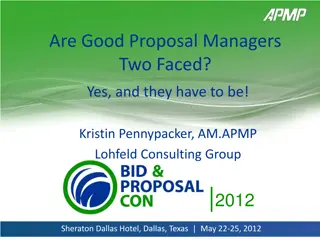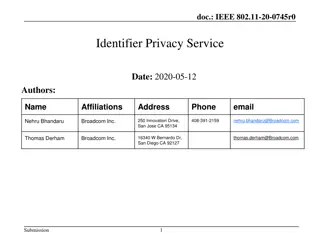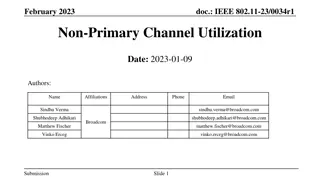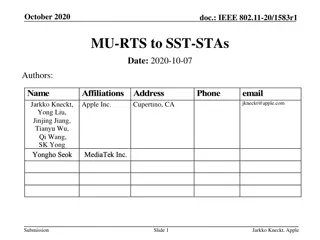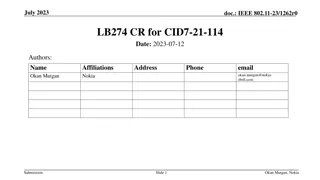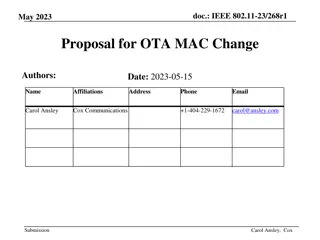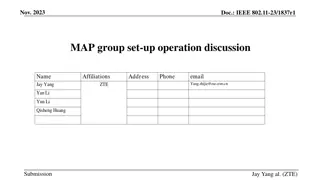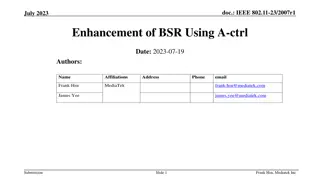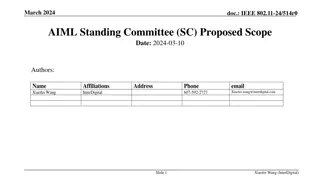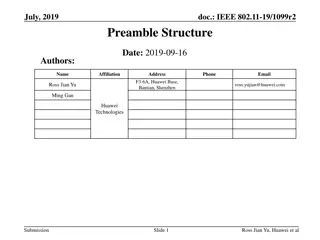Proposal for Mobile-AP Power Save in IEEE 802.11
This proposal by Neel Krishnan and team from Apple addresses the need to reduce power consumption in software-enabled access points (Mobile-APs). The focus is on prolonging battery life by minimizing power usage while ensuring full capabilities for associated STAs. The solution involves transitioning Mobile-APs between low-power listen mode and fully capable mode based on STA communication, enabling dynamic power-save scenarios. By optimizing power management in Mobile-AP operations, the proposal aims to efficiently handle sporadic traffic while conserving energy.
Download Presentation

Please find below an Image/Link to download the presentation.
The content on the website is provided AS IS for your information and personal use only. It may not be sold, licensed, or shared on other websites without obtaining consent from the author. Download presentation by click this link. If you encounter any issues during the download, it is possible that the publisher has removed the file from their server.
E N D
Presentation Transcript
doc.: IEEE 802.11-24/450r0 March 2024 A Proposal For Mobile-AP Power Save Date: 2024-03-12 Authors: Name Affiliations Address Phone Email Neel Krishnan Jarkko Kneckt Yong Liu Sid Thakur Anuj Batra neel_krishnan@apple.com 10500 N De Anza Blvd, Cupertino, CA, 95014 Apple Inc. Submission Slide 1 Neel Krishnan et al, Apple
doc.: IEEE 802.11-23/xxxxr0 November 2023 Abstract This presentation discusses a proposal to reduce Wi-Fi power consumption in a software-enabled access point (Mobile-AP) Submission Slide 2 Neel Krishnan et al, Apple
doc.: IEEE 802.11-23/xxxxr0 November 2023 Problem Statement Mobile APs (aka Soft-APs / Mobile hotspots) are typically battery powered devices that can act as Wi-Fi access points (E.g., cell phones, tablets, etc.) It is desirable to devise schemes that minimize power consumption of a device acting as a Mobile-AP to prolong its battery life o Reduction of power consumption of APs (including mobile APs) is highlighted in UHR SG [1] o Some relevant contributions in UHR SG regarding AP power save in references [2] [5] Associated STAs expect an AP / Mobile-AP to be always available at full capabilities maximum advertised receive channel bandwidth, data rate (MCS and number of spatial streams) o Associated STAs may transmit data to the Mobile-AP at any permitted BW and data rate at any time Being always available at full radio capabilities results in wasteful expenditure of power by the Mobile-AP, especially if the traffic to / from the associated STAs is light and sporadic o In the long term, most of the power / energy consumption stems from gratuitous listening to the wireless medium with full radio capabilities Submission Slide 3 Neel Krishnan et al, Apple
doc.: IEEE 802.11-23/xxxxr0 November 2023 Overview of Solution (1) Current Operation of Mobile-AP Proposed Operation of UHR Mobile-AP Submission Slide 4 Neel Krishnan et al, Apple
doc.: IEEE 802.11-23/xxxxr0 November 2023 Overview of Solution (2) The focus of this proposal is Mobile-AP operation in a single link Mobile-AP uses a low-power listen mode [6], [7] when listening to the channel and transitions to fully capable mode (with maximum advertised radio capabilities) only when actively transmitting or receiving frames o Low-power listen mode may be constrained in its radio capabilities compared to the fully capable mode (in terms of supported channel bandwidths, data rates, transmit capabilities etc.) o Low-power listen mode consumes less power [6] compared to listening in fully capable mode It is imperative that a STA indicates to the Mobile-AP about an upcoming uplink transmission so that the Mobile-AP is primed to receive it o Proposal UHR STA sends an initial-control-frame (ICF) to enable transition of UHR Mobile- AP from low-power listen mode to fully-capable mode of operation Key benefit of the proposal Enabling dynamic unscheduled power-save in a UHR Mobile-AP while effectively handling aperiodic traffic generated at associated UHR STAs Submission Slide 5 Neel Krishnan et al, Apple
doc.: IEEE 802.11-23/xxxxr0 November 2023 Operation of UHR Mobile-AP with UHR STAs UHR STA shall initiate each TXOP to UHR Mobile-AP with an initial-control-frame (ICF) with sufficient padding duration o UHR Mobile-AP shall indicate the requirement of ICF and the required padding duration in beacons / probe responses o The padding allows Mobile-AP to transition from low power mode to fully capable mode within the current TXOP o Mobile-AP may specify the maximum MCS and NSS at which the ICF frame shall be transmitted by a UHR STA UHR STA shall proceed with the TXOP only after it receives an immediate response (IR) frame from UHR Mobile-AP Submission Slide 6 Neel Krishnan et al, Apple
doc.: IEEE 802.11-23/xxxxr0 November 2023 Operation of UHR Mobile-AP with Unassociated UHR STAs Examples of unicast management frames sent by STA to an unassociated AP Unicast Probe Request, Association Request STA expects an immediate Legacy ACK in response to the unicast management frame that it transmits to the (Soft)AP Mobile-AP may be devoid of transmit capabilities when operating in low-power listen mode to minimize power consumption [6] Consequence Potential failure(s) of unicast management frames transmitted by unassociated STA (predicated on the time required at the Mobile-AP to enable fully-capable mode) UHR Mobile-AP indicates ICF (and padding) requirements in two ways (a) beacons, and (b) probe response frames sent in response to broadcast probe requests received from STA(s) Requirement UHR STAs should transmit an ICF (with sufficient padding) before transmitting unicast UHR Mobile-AP management frames to Submission Slide 7 Neel Krishnan et al, Apple
doc.: IEEE 802.11-23/xxxxr0 November 2023 Operation of UHR Mobile-AP with Pre-UHR (Legacy) STAs Recall that Mobile-AP, in low-power listen mode, is devoid of transmit capabilities Requirements of ICF cannot be imposed on pre-UHR STAs Two paths to pursue: o [Greenfield UHR BSS] UHR Mobile-AP lets only UHR STAs to associate with it (Use the protocol flow described in the previous slides) o UHR Mobile-AP lets any STA (UHR or pre-UHR) associate with it Pre-association behavior of UHR Mobile-AP with Legacy STAs: o STAs transmit management frames to unassociated (Mobile)APs in 20 MHz, basic rates o UHR Mobile-AP operating in low-power-listen mode should decode such management frames and respond appropriately Post-association behavior of UHR Mobile-AP with Legacy STAs: o UHR Mobile-AP shall disable low-power listen mode of operation if at least one pre-UHR STA is associated with it, if the Mobile-AP chooses to let pre-UHR STAs associate with it o This is to avoid regression in performance of the associated pre-UHR STA(s) Submission Slide 8 Neel Krishnan et al, Apple
doc.: IEEE 802.11-23/xxxxr0 November 2023 Quantification of Power Save Benefits Percentage reduction in Wi-Fi power consumption of Mobile-AP with low-power listen mode compared to always active in fully-capable mode TX and RX occur in 160 MHz, 2x2 Fully-capable mode Listening in 160 MHz, 2x2 Low-power listen mode Listening in low-power mode [6], [7] Wi-Fi power consumption data references [6], [8] Submission Slide 9 Neel Krishnan et al, Apple
doc.: IEEE 802.11-23/xxxxr0 November 2023 Summary Proposed operation of UHR Mobile-AP in low-power listen mode, when not actively transmitting/receiving frames, to reduce Wi-Fi power consumption Proposed the following operating principles in the context of UHR Mobile-AP and UHR STA: UHR Mobile-AP shall indicate the requirement of ICF and the padding duration for the ICF in beacons and probe responses o An associated UHR STA shall initiate each uplink TXOP to a UHR Mobile-AP with an ICF with sufficient padding duration, if indicated by the UHR Mobile-AP o UHR STA shall transmit the ICF to UHR Mobile-AP in non-HT duplicate format o UHR Mobile-AP may indicate the maximum MCS and NSS at which the ICF can be transmitted by a UHR STA; the UHR STA shall abide by these requirements, if indicated by UHR Mobile-AP o An unassociated UHR STA should transmit an ICF to the UHR Mobile-AP before transmitting unicast management frames (unicast probe response, association request, etc.) o Submission Slide 10 Neel Krishnan et al, Apple
doc.: IEEE 802.11-23/xxxxr0 November 2023 References 1. IEEE 802.11-23/480r3, UHR Proposed PAR 2. IEEE 802.11-23/0010r0, Considerations for enabling AP power save 3. IEEE 802.11-23/0015r0, AP MLD power management 4. IEEE 802.11-23/225r0, Considering Unscheduled AP Power Save 5. IEEE 802.11-23/244r1, AP Power Save PAR addition proposal 6. IEEE 802.11-22/1414r1, Low Power Listening Mode 7. IEEE 802.11-22/1841r0, Follow up on the low power listening 8. IEEE 802.11-14/0980r16, TGax Simulation Scenarios Submission Slide 11 Neel Krishnan et al, Apple
